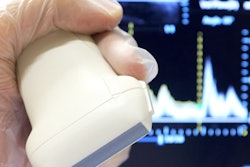
For advocates of ultrasound contrast, the recent U.S. Food and Drug Administration (FDA) approval of Lumason from Bracco Diagnostics for characterizing liver lesions was a long overdue moment that will likely serve as a catalyst for broad adoption of these agents -- and not just in the liver.
First of all, this month's FDA approval offers incredible potential for patient care, patient safety, and optimal management of liver tumors, especially in those patients at risk for hepatocellular carcinoma (HCC), said Dr. Stephanie Wilson, co-chair of the International Contrast Ultrasound Society (ICUS) and a clinical professor of radiology and gastroenterology at the University of Calgary.
"Microbubble contrast agents, including Lumason, are easy to use, are cost-effective, and provide a brand new arena in which the investigation of liver masses may now expand," she said. The approval paves the way for employing contrast-enhanced ultrasound (CEUS) in liver indications that are typically being imaged now in the U.S. by CT or MRI, according to Wilson.
A logical choice
Because characterizing liver masses is the most important indication for CEUS, it was a logical choice for the first approved indication in radiology, said Dr. Edward Grant, an ICUS board member and chairman of radiology at the University of Southern California (USC) Keck School of Medicine.
"CEUS performs well in this area, and there is a huge body of existing literature outside of the USA supporting it," Grant said.
Liver masses are common -- 5% to 10% of the population is believed to have one -- and most are incidentally discovered and benign. Until now, patients in the U.S. were typically referred for a contrast-enhanced CT or MR, Grant said.
"However, most liver masses can be characterized definitively on the spot with CEUS -- end of workup," he said.
A large number of cirrhosis patients are screened for HCC using noncontrast ultrasound every six months or even more frequently, Grant said. In the U.S., these masses identified on ultrasound would also typically be sent for a contrast-enhanced CT or MR.
"However, most can be definitively characterized using CEUS, avoiding CT/MR in cases of benign tumors and, thus, decreasing cost and radiation exposure," he said.
Access to ultrasound contrast agents for characterizing masses in patients with renal failure also represents a huge leap forward, Grant said.
"As with CEUS for the liver, CEUS for the kidney can be a problem-solver since it can be used to characterize masses seen on CT or MR that are indeterminate, or, as we use it, as a first-line agent to characterize masses seen on noncontrast [ultrasound]," he said. "This helps avoid many costly CT/MRIs and also avoids radiation in the case of CT."
Triggering broad expansion
In the absence of FDA approval for ultrasound contrast in radiology applications, many ultrasound contrast advocates had been recommending the off-label use of ultrasound contrast agents for noncardiac indications. Despite those efforts, off-label adoption has remained largely limited to academic medical centers.
The FDA approval of Lumason for characterizing liver lesions, however, is a game-changing moment for the use of ultrasound contrast agents, Grant said.
Prior to approval, many radiologists hesitated to use ultrasound contrast agents off-label for a variety for reasons, including the mistaken belief that they could not get reimbursed for off-label use. In addition, some in leadership positions simply refused to allow off-label contrast use in their departments, citing the lack of approval.
As an added complication, representatives from ultrasound contrast vendors could not speak to radiologists about contrast for legal reasons, Grant said.
"And most people in the major ultrasound companies in the radiology market have had little or no experience with ultrasound contrast agents, making it doubly difficult for practitioners to get started," he said.
The approval should also go a long way toward easing the minds of referring physicians.
"Now that we have an FDA approval for liver, I think our oncologists will feel more comfortable referring patients for contrast-enhanced ultrasound," said Dr. Richard Barr, PhD, from Northeast Ohio Medical University. "I think they were a little concerned before when it was off-label use, especially if they weren't doing studies."
Indeed, clinicians may soon expect the availability of CEUS, according to Grant.
"As the benefits of contrast [ultrasound] become more well-known in the USA, clinicians will eventually expect radiologists to step up, or risk having nonradiologists provide the service," Grant told AuntMinnie.com. "A perfect example would be a patient with renal failure who cannot have contrast-enhanced CT or MR. Once it becomes known that contrast-enhanced ultrasound studies are available, urologists will demand them for their patients' sake."
Pediatric benefit
The approval also marks a major shift toward acceptance of CEUS in children and will herald its introduction as a diagnostic option, said Dr. Kassa Darge, PhD, an ICUS board member and chief of body imaging at the Children's Hospital of Philadelphia (CHOP).
"It goes from something more like a 'research' application to routine clinical use," Darge said. "In addition, it opens up the possibility of reimbursement. It is amazing to see the increase in requests for information regarding pediatric CEUS applications just in the first week of the approval."
CEUS has been used routinely in pediatrics in Europe since the late 1990s, and since then to a lesser extent in Asia, Australia, and South America. The main pediatric application for CEUS is actually intravesical injection for detecting vesicoureteric reflux, Darge said.
"The patients for this indication are many more than the patients having the indications for intravenous contrast administration of the [ultrasound] contrast agents," he said.
Intravenous CEUS in children does provide major improvements, however, including the ability to perform an ultrasound study instead of exposing patients to radiation with CT or fluoroscopy.
"Furthermore, with CEUS it is possible to do a study without sedation, unlike MRI in small children," Darge said. "Thus, with pediatric CEUS we are able to avoid radiation and sedation in children for selected indications. Other advantages include the ability to do CEUS as a bedside study and the possibility to administer [ultrasound] contrast agents in patients with reduced renal function."
In the liver, the most important applications for pediatric CEUS are the detection and characterization of focal liver lesions, assessment for blunt trauma, and evaluation for disseminated infections, according to Darge.
CHOP has been using ultrasound contrast agents off-label for routine clinical indications for almost two years; these indications go beyond the liver to include assessment for blunt abdominal trauma (including spleen, kidneys, and pancreas); detection and characterization of focal lesions also in the spleen, kidneys, and pancreas; and evaluation of the bowel in children with inflammatory bowel disease.
"We have [also] expanded the use beyond contrast-enhanced voiding urosonography with intravesical administration to applications for pediatric interventional radiology in the setting of renal angioplasty or pleural drainage procedures," he said.
Other indications?
Should companies feel that additional approvals are warranted, USC's Grant recommends evaluating the use of CEUS in kidney imaging.
"In our practice, we probably use ultrasound contrast in the kidney almost as frequently as we do for the liver," Grant said. "We routinely use it to characterize indeterminate masses on CT/MR, or complex masses seen on noncontrast [ultrasound]. It is also an excellent method to follow up patients who have undergone partial nephrectomy for renal cell carcinomas, since many of these patients will experience some form of renal failure after the surgery."
Barr said that characterizing renal masses is the biggest use for CEUS at Northeast Ohio Medical University.
"We get much better results [with CEUS] in characterizing renal masses than CT and MR," he said.
While characterizing liver lesions has been the most popular and also the most successful pursuit worldwide for CEUS in radiology, nonhepatic indications are equally exciting and many of them are "incredibly successful," Wilson said.
"Renal mass evaluation [with CEUS], where performed, becomes an essential tool for urologists," Wilson noted. "My own great interest in the use of microbubble contrast agents for assessing inflammatory activity in [inflammatory bowel disease] is an exciting and expanding arena that shows the great value of quantification of blood flow, which can be done with CEUS related to the purely intravascular location of the microbubbles. This objective biomarker of disease will hopefully be standard care in the future."
The use of CEUS to monitor chemotherapy treatment response will also likely be a very important application in the future, Barr said. Performing that task with multiple CT and MR exams is not very efficient, and in the case of CT, it exposes patients to a lot of radiation.
"There are a lot of groups working on how to apply [CEUS] now in monitoring chemotherapy treatment," he said.
Vendor moves?
What remains to be seen is whether or not other ultrasound contrast firms will pursue FDA approval for these and/or other radiology applications.
A GE Healthcare spokesperson declined to comment on the company's plans for submitting its Optison agent for FDA approval in radiology indications. However, the firm "sees the approval of contrast imaging for ultrasound in the liver as a positive and pivotal moment in the history of ultrasound in the U.S."
"As an industry leader in both ultrasound and contrast, we have worked closely with clinicians globally to ensure that our products excel in this important clinical application, and we are excited about the potential to improve healthcare with this important new clinical capability," the spokesperson told AuntMinnie.com.
Mary Anne Heino, president and CEO of Lantheus Medical Imaging, said it's the company's policy not to comment on ongoing regulatory discussions with the FDA. However, she noted that Definity has been approved in 40 countries worldwide, with approvals for abdominal imaging of the liver and kidneys in five of those markets.
What's more, Lantheus is teaming with its partner Double Crane in China to seek approval for both cardiac and abdominal imaging, and it's also in the process of obtaining approval for cardiac and abdominal imaging in Taiwan, she said.
"Definity has been used in more than 6.7 million patients worldwide since commercial approval," she said. "Lantheus has an extensive database of clinical data and publications for Definity."
In commenting on the new FDA approval for Bracco's Lumason agent, Heino said that Lantheus welcomes additional clinical work that demonstrates the safety and value of contrast agents.
"Demonstration of the clinical benefit of contrast use helps healthcare practitioners and the patients they serve," Heino said. "Lantheus welcomes and supports all industry efforts to better characterize the value of contrast use."
As for Bracco, the company is pursuing additional noncardiac and cardiac indications in the U.S. for Lumason, focusing on areas the firm believes Lumason-enhanced ultrasound would bring the most clinical value, said Dr. Alberto Spinazzi, senior vice president of global medical and regulatory affairs for the Bracco Group.
"We are in advanced stages of development, either phase III of clinical testing or preparing the application," he told AuntMinnie.com.
A bright future in pediatrics
Thanks to the new approval of Lumason, ultrasound contrast use in pediatrics has a much brighter future in the U.S., Darge said.
"This will not only spur the routine clinical use, but also will be instrumental in advancing innovative research projects in pediatric CEUS," he said. "This will also open the door for future approval expansion of the indication for intravesical use. It may also motivate other [ultrasound] contrast agent manufacturers to follow suit and seek pediatric approvals."
The advantage of not using ionizing radiation will be a key selling point for CEUS, particularly for pediatric radiologists, Barr said.
"I think the pediatric radiologists will accept it much more rapidly than the adults," he added.
The long-awaited approval is a very exciting development that opens new doors for the use of ultrasound, according to Grant.
"Radiologists in the USA will finally be on a par with those practicing in the rest of the world," he said. "However, we cannot underestimate the need for education as well as further research and development leading to improved agents and equipment."
While it's a very exciting time for ultrasound contrast, widespread adoption of CEUS won't happen overnight, Barr noted.
"There is a fair learning curve in getting the sonographers, the radiologists, and everybody onboard to use the agent," he said.
The long delay in getting approval for radiology applications has had a negative effect on U.S. radiologists, and the practice standards are firmly established, Wilson said. On the bright side, she noted, the American College of Radiology's Liver Imaging Reporting and Data System (LI-RADS) Committee recently added CEUS along with CT and MR for liver imaging in patients at risk for HCC.
"I hope very much that the role of CEUS for so many important capabilities will grow in the years ahead," Wilson said.




















